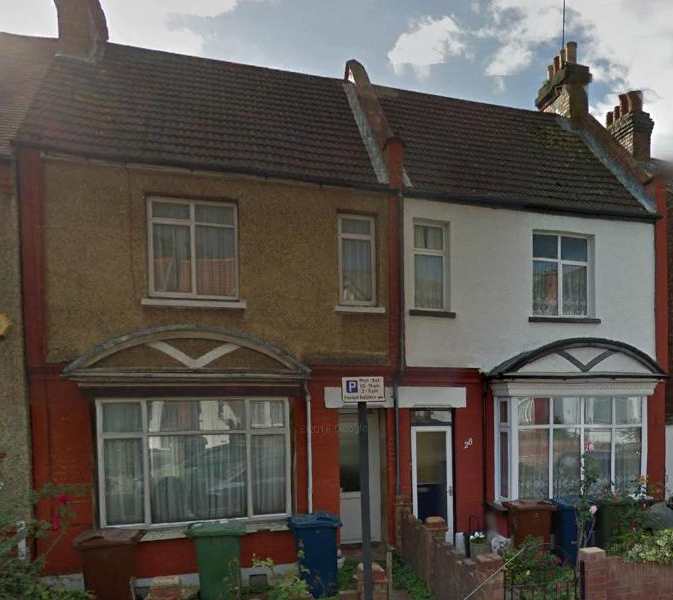
Figure 1. The Coaley Home at 28 Parkfield Road in Harrow (house on the right).
(Photograph courtesy of Google Earth)
111069 Pioneer
WILLIAM JOHN COALEY
Royal Engineers
(later 290225 Private, Pioneer Corps)
The Coaley Family
William
John Coaley was born in April of 1866 at Stoke Goldington, Buckinghamshire, the
son of William John Coaley (1828-1891) and Elizabeth Coaley [née Haycock]
(1840-1913). William John was the
first born of William and Elizabeth Coaley, but the Coaleys had seven additional
children. William John’s siblings
were:[i]
Ellen
Coaley (1869-1904) born in Stoke Goldington.
Charles
Coaley (1871-?) born in Stoke Goldington.
Arthur
Coaley (1871-?) born in Stoke Goldington.
NOTE: Charles and Arthur probably were twins who died at birth or in
infancy.
Walter
Henry Coaley (1873-1904) born in Stoke Goldington.
Jesse
Coaley (1875-1938) born in Stoke Goldington.
Ada
Elizabeth Coaley (1877-?) born in Clifton Reynes, Buckinghamshire.
Mary
Amelia Coaley (1881-?) born in Horton, Northampstonshire.
The
Residences of William and Ellen Coaley
As a
young man William John Coaley lived with his parents in Stoke Goldington,
Buckinghamshire and Horton, Northamptonshire until the 26th of
October 1885 when he married Ellen Tyso Pettitt (1862-1954), a spinster, in
Newport Pagnell, Buckinghamshire.[ii]
William apparently did not have much of an education or training to allow
him to work in a particular trade, so he became a general labourer.
This line of work caused him and Ellen to move numerous times in order
for him to go where the work was to be had.[iii]
From
1886 to 1887 they resided in Newport Pagnell where they were married.
They probably lived with Ellen’s family.
In
1889 they were living in Horton, Northamptonshire, in 1891 they were residing in
Olney, Buckinghamshire, and by 1893 they were back in Newport Pagnell.
Sometime
before 1896 they left Buckinghamshire and moved to Middlesex where they lived in
Perivale, in Brentford in 1900, in Ealing in 1901 and back to Brentford in 1904.
In
1907 the Coaleys were back in Buckinghamshire in the town of Wendover, but by
1911 they were back in Middlesex, residing in Harrow on the Hill.
They had made eleven moves in 24 years - an unusual number for the
average English family, but perhaps not that unusual for an itinerant labourer.
Their move to Harrow probably resulted in some stability for the family,
as it will be seen later in this narrative, where William apparently landed a
more permanent job with a gas works.
The
Children of William and Ellen Coaley
Movement
to many different towns between 1886 and 1907 did not seem to prevent the
Coaleys from raising a rather large family, much like William’s mother and
father had. Ellen Coaley gave birth
to nine children between 1886 and 1907!!! Their
first child, Maud was born in Newport Pagnell in 1886.
Maud does not appear in Pioneer Coaley’s military service papers in
1915 as she was 29 years old by that time and probably married.
Harriet also was born in Newport Pagnell, in December of 1887.
She would have been 28 years old in 1915 and like her sister she does not
appear in Coaley’s service papers, probably because she had married by then.
The
Coaley’s first son, Alwin George C. Coaley was born in Horton,
Northamptonshire in September of 1899. Unfortunately
young Alwin only lived to the age of 11 years.
Violet
Rose was born on the 28th of September 1891 in Olney,
Buckinghamshire, and like her older sisters she does not appear in Pioneer
Coaley’s service papers, probably because she was 24 years old and married by
1915. Winifred May was born in
July of 1893 in Newport Pagnell and again, like her other sisters, she does not
appear in Coaley’s papers.
The
next four children are listed on Pioneer Coaley’s Descriptive Report on
Enlistment and except for one their exact dates of birth are listed.
His name sake, William John Coaley was born in October 1896 at Perivale,
Middlesex. He died in December 1965 at Brent, Greater London. Henry Thomas
Coaley was born on the 6th of August 1900 at West Ealing.
He died in Paddington, London in March of 1922.
Florence Ellen Coaley was born on the 22nd of March 1922 at
Brentford, Middlesex and their last child Alice Isabel Coaley was born on the 6th
of January 1907 at Princes Risborough, Buckinghamshire.[iv]
Military
Service
Perhaps
out of a sense of patriotism, or perhaps because it was difficult to find work
as a general labourer and support his family, William John Coaley decided to
join the Army about one year after the start of the Great War of 1914-1918.
On the 3rd of August 1915 he attested for short service at
London for the duration of the war. He
was 46 years of age at the time.
Coaley
was living at 28 Parkfield Road in Roxeth, South Harrow, London at the time of
his enlistment. At the time of his
attestation he answered the following questions that normally were put to a new
recruit:
·
He was a British
subject
·
He was a Labourer.
·
He was married.
His wife’s name was Ellen Tyso Coaley and he had four children, listing
the four noted in the last paragraph of the previous section.
·
He had no prior
service in His Majesty’s forces.
·
He was willing to be
vaccinated.
·
He was willing to
enlist for General Service.
·
He was willing to
serve for the duration of the war.

Figure 1.
The Coaley Home at 28 Parkfield Road in Harrow (house on the right).
(Photograph courtesy of Google Earth)
On
the same day as his attestation he was given a medical examination.
As a result of this examination he was noted to be 5 feet 9½ inches
tall, with a chest measurement of 36½ inches when full expanded and a range of
chest expansion of 2 inches. His
attestation papers also show that his religion was listed as Church of England.
The
results of his medical examination indicated that he was fit for service in the
Royal Engineers, although overage for assignment to a front line unit.
On the 6th of August 1915 he joined his unit at Southampton,
“A” Company of the 2nd Labour Battalion, Royal Engineers.
His assignment to this unit was undoubtedly due to his age and maybe his
experience as a labourer.
During
June 1915 both Royal Engineers and infantry labour battalions had been formed in
England and were being sent overseas for work in army areas, mainly on road
maintenance work. These units were formed from men of the navvy class and from
men who were over military age or from men who, because of wounds, injury or
illness, were no longer fit for front line combat service. The overage personnel
were enlisted at a special rate of pay of 3 shillings per day.
William John Coaley certainly qualified for service in one of these
battalions.[v]
The
2nd Labour Battalion, R.E. departed from Southampton and landed at
Havre, France on the 23rd of August 1915.[vi]
Coaley’s Medal Index Card (MIC), shown below, does not indicate the
date of his entry into the Theatre of War as it normally did for men who served
abroad. Another error in the card is
the omission of his award of the 1914-15 Star Medal, which is listed in his
service papers, and which he did indeed receive.
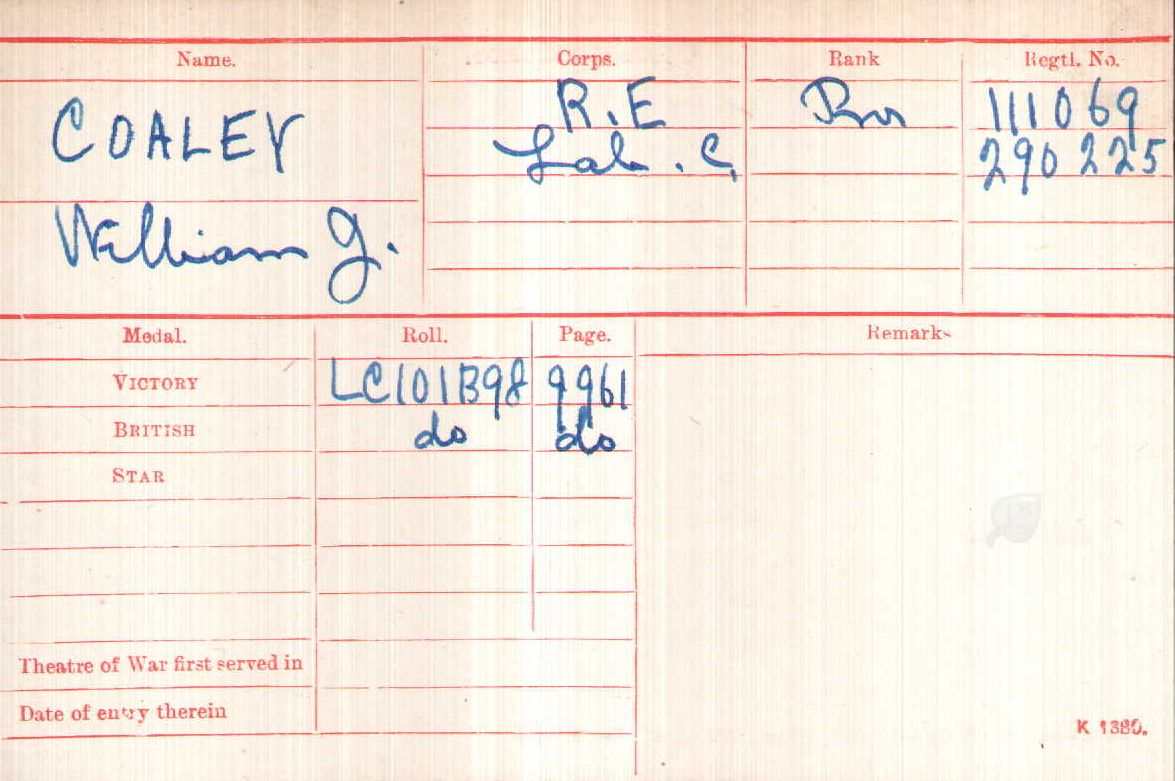
Figure 2.
The Medal Index Card of William John Coaley, R.E. and Labour Corps.
(Image
courtesy of Ancestry.com)
Coaley
acknowledged receipt of the 1914-15 Star as shown in this correspondence with
the Labour Corps Record Office dated 9-12-1920.
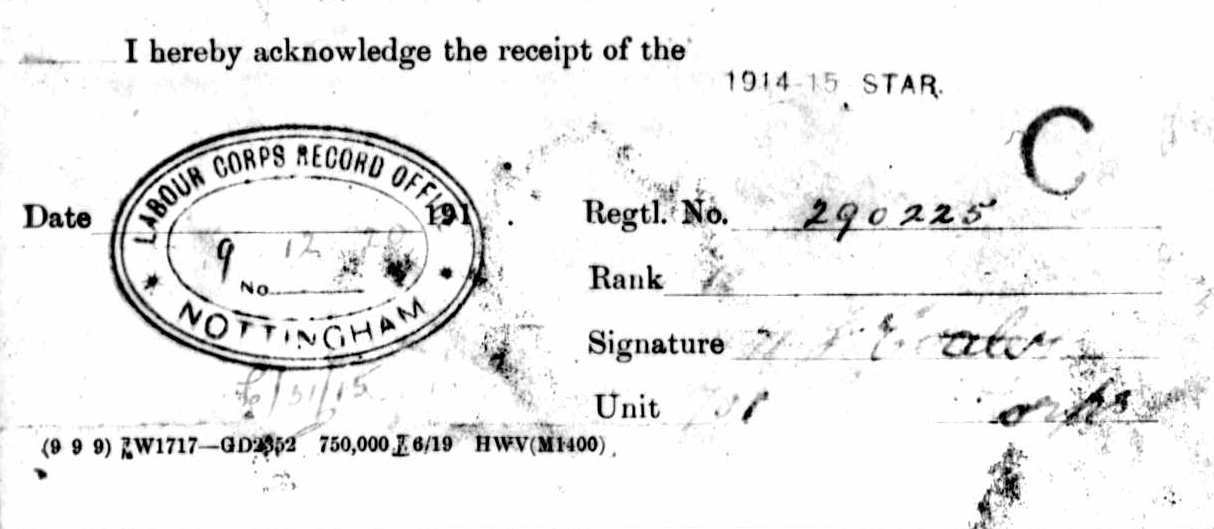
Figure
3. Coaley’s Receipt for the
1914-15 Star.
(Image
from the National Archives, London)
Omissions
of this type, while not common, frequently can hamper research efforts when
trying to obtain accurate data regarding the service of a solider during the
Great War.
Coaley’s
service papers contain an entry indicating that he was absent without leave
during the period from the 21st to the 22nd of September
1915 while his unit was near Doullens. He
was placed in open arrest, but no details beyond this are contained in his
papers.
The
War Diary of the 2nd Labour Battalion, R.E. (701st Labour
Company) contains no information regarding the movements or work of Coaley’s
battalion for the remainder of 1915 except an entry indicating that the unit
moved from Havre to Doullens on the 28th of August.
The only mention of the unit in 1916 indicates that on the 2nd
of September the battalion was working under the supervision of General
Headquarters in France and Flanders. It
may be assumed that the battalion was working on general engineer works, road
construction and road maintenance and railway construction and railway
maintenance in the rear area. On the
5th of January 1917 the 2nd Labour Battalion, R.E. lost
its first and only man. He was
111161 Acting Corporal Charles C. Scrivens who died of wounds.[vii]
Coaley
was transferred to the 701st Labour Company in the newly formed
Labour Corps in early January of 1917. As
with the Labour Battalions of the Royal Engineers, this Corps was manned by men
who were either ex-front line soldiers who had been wounded or taken ill or men
who on enlistment were found to be unfit for front line service because of ill
health or because they were too old. Coaley
certainly qualified based on his age of 46 years at the time of his enlistment.
With this new posting his rank was changed from Pioneer to
Private and his regimental number from 111069 to 290225.
The
War Diary of the 2nd Labour Battalion, 701st Labour
Company, picks up in detail on the 15th of April 1917 showing the
movement and work of the unit as follows:
|
15 Apr 1917: |
2nd
Labour Battalion, working in the Fifth Army area moves from Bapaume to
Fremicourt. The unit is
employed on road construction work. NOTE:
Although
the Labour Corps had been formed in January of 1917 the unit war dairy
still referred to Coaley’s company using the 2nd Labour
Battalion designation. The
entries in the diary did not begin referring to the unit as the 701st
Labour Company until September when the company officially was formed. |
|
|
|
|
10-12 May 1917: |
2nd
Labour Battalion moves from Fremicourt, apparently en route to Butte De
Warlencourt. |
|
|
|
|
25 May 1917: |
2nd
Labour Battalion ordered to move to 58th Group.
|
|
|
|
|
26 May 1917: |
2nd
Labour Battalion moves to 58th Group, Fifth Army. |
|
|
|
|
30 May 1917: |
2nd
Labour Battalion at Fremicourt. |
|
|
|
|
1 Jul 1917: |
2nd
Labour Battalion working on light railways. |
|
|
|
|
1 Sep 1917: |
701st
Labour Company formed from the 2nd Labour Battalion.
The company is working on light rail construction. |
|
|
|
|
3 Oct 1917: |
701st
Labour Company working in IV Corps area. |
The
Harrow and Stanmore
Gas Company
Office – Gas Works, Harrow
Middlesex
CHAS.
CHAMBERS
Engineer
and Manager
December
4th., 1917
The
Officer in Charge
Labour
Corps Records,
Nottingham
Dear
Sir,
I understand that Mrs. Coaley is in delicate health and is anxious for
her husband to be released from the Army. I
think you have had the application forwarded from Chatham.
I should like to say that if it is possible for this man to come back I
shall be very glad to employ him. He
worked at this Works for some years before joining up, being, I believe over-age
and not engaged on any important duties, you may find it possible to release
him. If so, I can assure you that he
can resume his old employment.
His name is J. [sic] Coaley, 290225.
Yours
faithfully,
Charles Chambers
This letter sparked a good deal of War Office correspondence related to Coaley’s release from the Army and assignment to the Class P or P(T) Reserve. These reserve classes were for men whose services were deemed to be temporarily of more value to the country in civil life rather than in the Army. Given Mrs. Coaley’s ill health, Coaley’s age and the fact that he was to be employed at a gas works all worked in his favor. On the 18th of March 1918 his transfer to the Class P Reserve was approved and the War Office sent a request to the Deputy Adjutant General, General Headquarters, 3rd Echelon, France to release Coaley to work at The Harrow and Stanmore Gas Company. On the 14th of April 1918 Coaley was posted to the London Corps Labour Centre from his unit that was at that time at Boulogne. On the 28th of May he was transferred to the Class “P” Reserve and was discharged from the Army at Nottingham on the 30th of January 1919.
William John Coaley received his 1914-15 Star on the 9th of December while he was living at 28 Parkfield Road, Roxeth, South Harrow, London.[ix] He received his British War Medal on the 28th of February 1921 and his Victory Medal on the 25th of October while living at the same South Harrow address. Coaley’s Victory Medal is in the author’s collection.
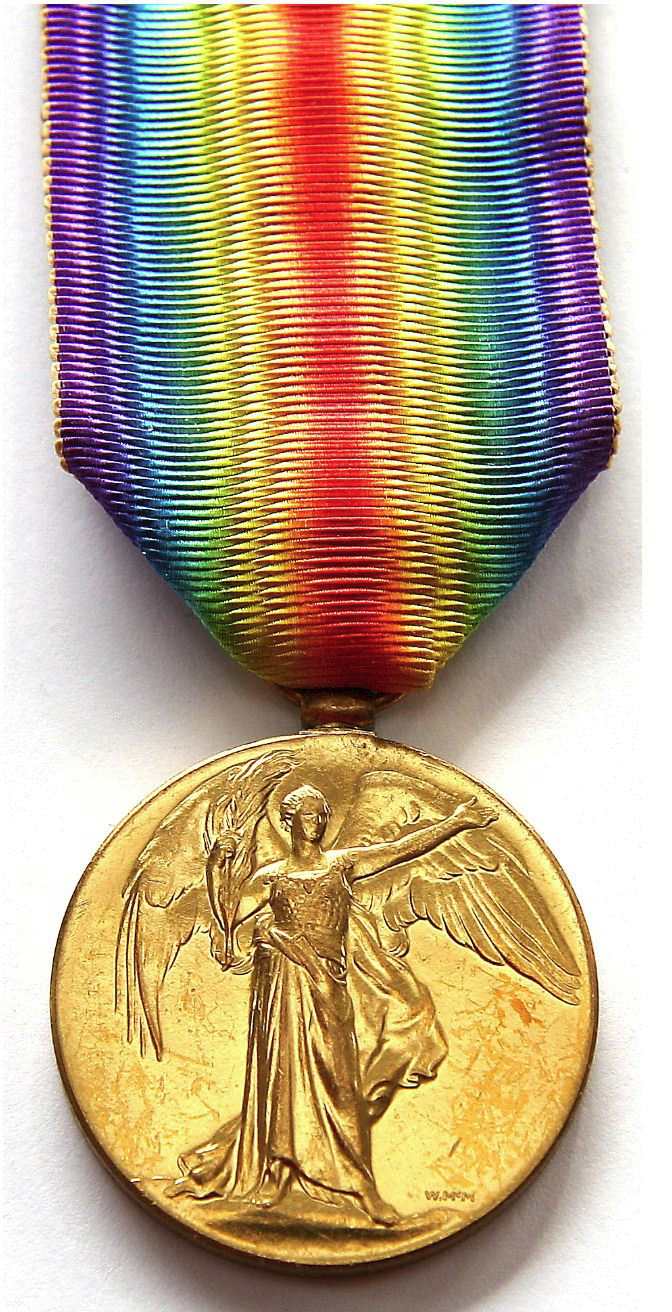
Figure
4. The Victory Medal of William John
Coaley.
(Photograph from the Author’s collection)
William John Coaley and his wife lived in Harrow from 1926 until his death in 1937. He passed away in December of 1937 at Hendon, Middlesex. His wife Ellen continued to live in Harrow where she died in September of 1954.[x]
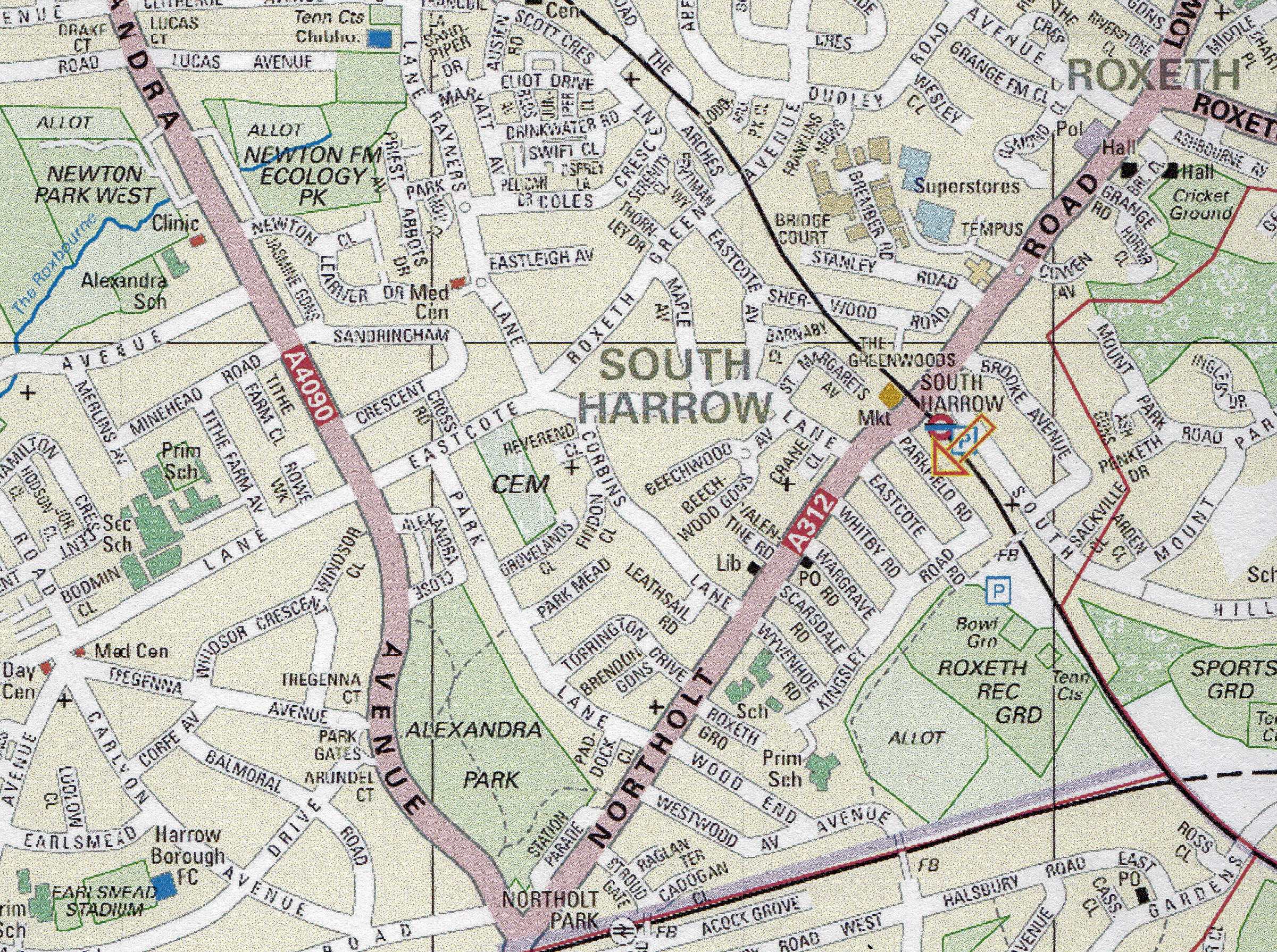
Figure
5. Parkfield Road in South Harrow,
Location of the Coaley Home.
(Map courtesy of Steetmaps.co.uk)
REFERENCES
1.
Short
Service Attestation.
2.
Descriptive
Report on Enlistment.
3.
Receipt
for the Victory Medal (Army Form B. 5112).
4.
Registered
Post Parcel Envelope, 25 Oct 1921.
5.
Registered
Post Parcel Envelope, 20 Feb 1921.
6.
Receipt
for the 1914-15 Star.
7.
Receipt
for the British War Medal.
8.
Letter
from the Manager, Harrow and Stanmore Gas Company, Harrow, Middlesex to the
Officer in Charge, Labour Corps Records, Nottingham, dated December 4th 1917,
re: Early release from the Army of W.J. Coaley.
9.
Notification
of Transfer to Class P or P(T) Reserve.
10.
Statement
of Services.
11.
Casualty
Form – Active Service (Army Form B. 103).
12.
Classes
of the Army Reserve – The Long Long Trail and Wikipedia.com
13.
Letter
from the Director of Mobilisation to the Deputy Adjutant General, GHQ 3rd
Echelon, France dated 18th March 1918, re: Request to Release Coaley
to work in the Harrow and Stanmore Gas Works.
14.
1901
Census of England and Wales (RG13/1192).
15.
Death
Index, 4th Quarter 1965.
16.
Tomlinson
Family Tree (Ancestry.com).
17.
Electoral
Registers 1926 – 1937.
18.
1871
Census of England and Wales.
19.
1881
Census of England and Wales.
20.
1891
Census of England and Wales.
21. 1911 Census of England and Wales.
22.
The Work of the Royal Engineers
in the European War, 1914-1919. Work Under the Director of Works (France). The
Institution of Royal Engineers, Chatham, Kent, 1924, p. 185.
23.
The Work of the Royal Engineers
in the European War, 1914-1919. Miscellaneous. The Institution of Royal
Engineers, Chatham, Kent, 1926, pp. 16 and 17.
24.
The
Service of 111863 Pioneer John Savage, R.E. www.reubique.com/111863
Savage.htm
25.
War
Diary of the 2nd Labour Battalion, R.E. (701st Labour
Company).
26.
The
Labour Corps of 1917-1918, https://www.longlongtrail.co.uk/army/regiments-and-corps/the-labour-corps-of-1917-1918/
ENDNOTES:
[i]
Reference 16.
[ii]
Ibid.
[iii]
Ibid.
[iv]
Ibid.
[v]
References 22 and 23.
[vi]
Reference 24.
[vii]
Scrivens
had been born in Clerkenwell, Middlesex and was residing in Battersea,
Surrey when the war broke out. He
enlisted in the Royal Engineers at London.
[viii]
Reference 26.
[ix]
Reference 6.
[x]
Reference 16.